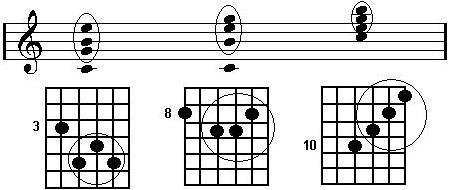When one deconstructs a 7th chord a triad is discovered. Play a Cmaj7 chord in root position. Now eliminate the root and play just the upper 3 notes and you will find that it's an E minor triad. So we could say that Cmaj7 = Em/C. That is, an Emi triad over a C bass note. Here are 3 common voicings for Cmaj7 on the guitar. In every case, some form of the Emi triad is found in the upper part of the chord.

All types of 7th chords consist of some kind of triad over a bass note that's not in the triad. The triad is known as an "upper extension triad". The upper extension triads of the 5 types of 7th chords are these:

The implications of this for soloing involve thinking and playing in terms of the upper tonality while never losing sight of the "parent" chord. So for Cmaj7 you would solo in E minor. Your hand is "thinking" in terms of E minor even though your brain knows that the chord is Cmaj7.
So now triad arpeggios must be mastered. The material for this is in Unit 3 of my book, Vertical Truth, Chordal Mechanisms for the Guitar. I also recommend the triad exercises in Patterns for Jazz by Jerry Coker. The concept is the same as what I've heretofore presented with 7th arpeggios - add 2nds &/or 4ths to triad arpeggios to create melodic fragments.


